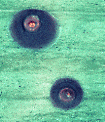 |
 |
The information on this page is copyrighted, but it may be used freely for educational purposes if cited as follows:
Hamon, A.B. 1998. Armored scale insects as pests of bromeliads. Published on WWW at: http://BromeliadBiota.ifas.ufl.edu/scale.htm
Family Diaspididae - Armored scale insects
As the common name implies, these insects are covered by a non-living waxy armor. This armor affords the insect excellent protection from the elements and from control efforts. Penetration through this armor with contact insecticides is very difficult. In many cases the answer is to use a systemic insecticide.
The life cycle for armored scale insects is different for each sex. The females pass from egg to crawler (1st instar) to second instar to third instar or adult. Female nymphs lose their legs at the first molt, and remain sessile at that spot for the remainder of the life span. They form an armor from secreted waxes and the cast skins. The males begin the same as females, but usually produce a differently shaped armor which is completed by the end of the second stage. Mouthparts are lost at the second molt, and thereafter the males are unable to feed, although they continue to develop and pass through what are called the prepupal and pupal stages to become adults. Some adult males are wingless, whereas others have one pair of wings and resemble small flies. Since the males are unable to feed and soon die, they must find a female quickly (within one day) for mating to occur.
Common Species on Bromeliads
Chrysomphalus aonidum (L.)


Florida red scale
Female armor: Circular, moderately convex, dark reddish brown to almost black, margin somewhat ash gray. Size is about 2 mm in diameter. The exuviae (cast skins) are approximately central, reddish brown or brick red, sometimes covered with grayish secretion, surrounded by a reddish brown ring (Dekle 1976).
Diaspis boisduvalii Signoret


Boisduval scale
Female armor: Circular or oval, thin, flat, white to light yellow, semitransparent. Size is 1.2-2.25 mm in diameter. Exuviae central to subcentral, white to light yellow (Dekle 1976).
Diaspis bromeliae (Kerner)
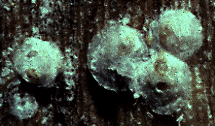
pineapple scale
Female armor: Nearly circular, flat, yellowish white to brownish yellow, semitransparent. Size 2-3 mm in diameter. Exuviae subcentral, yellowish or pale brown (Dekle 1976).
Gymnaspis aechmeae Newstead
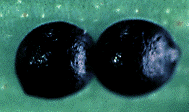
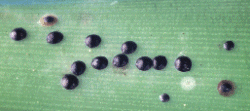
flyspeck scale
Female armor: Circular or gumdrop shaped, very convex, opaque, brittle, shiny black or bronzy black. Size 0.8-1.25 mm in diameter. The second exuviae encase the insect (pupillarial form) (Dekle 1976).
Hemiberlesia lataniae (Signoret)
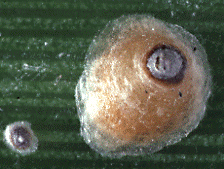
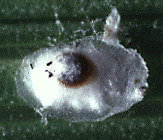
lataniae scale, closeup of the lataniae male, right
Female armor: Circular, strongly convex, usually a dirty white to beige depending on the host plant. Size 1.5-2.0 mm. Exuviae large, pale brown, central to subcentral; usually covered with a scant, light colored secretion (Dekle 1976).
Hemiberlesia palmae (Cockerell)
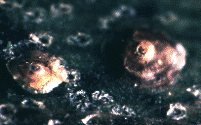
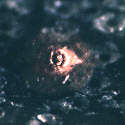
tropical palm scale
Female armor: Circular or oval, very strongly convex, light brown to dark brown or straw colored. Size 1.75-2.25 mm. Exuviae subcentral, slightly darker in color than the secreted cover (Dekle 1976).
Ischnaspis longirostris (Signoret)

black thread scale
Female armor: Long, slender, threadlike, sides parallel, very convex, shiny black. Size 2.0-3.5 mm long. Exuviae terminal, brownish (Dekle 1976).
Parlatoria proteus (Curtis)
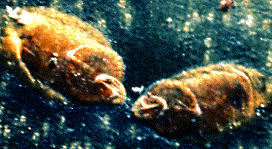

proteus scale
Female armor: Elongate oval, convex, transparent, greenish or grayish yellow, margins lighter. Size 1.0-2.0 mm long. Exuviae marginal, yellowish or brownish; second exuviae large, well defined, often about one-third the length of the armor (Dekle 1976).
REFERENCES:
Dekle, G.W. 1976. Florida armored scale insects. Arthropods of Florida and Neighboring Land Areas 3: I-vii, 1-345.